
Posted on 08/05/2014 5:30:18 AM PDT by Homer_J_Simpson

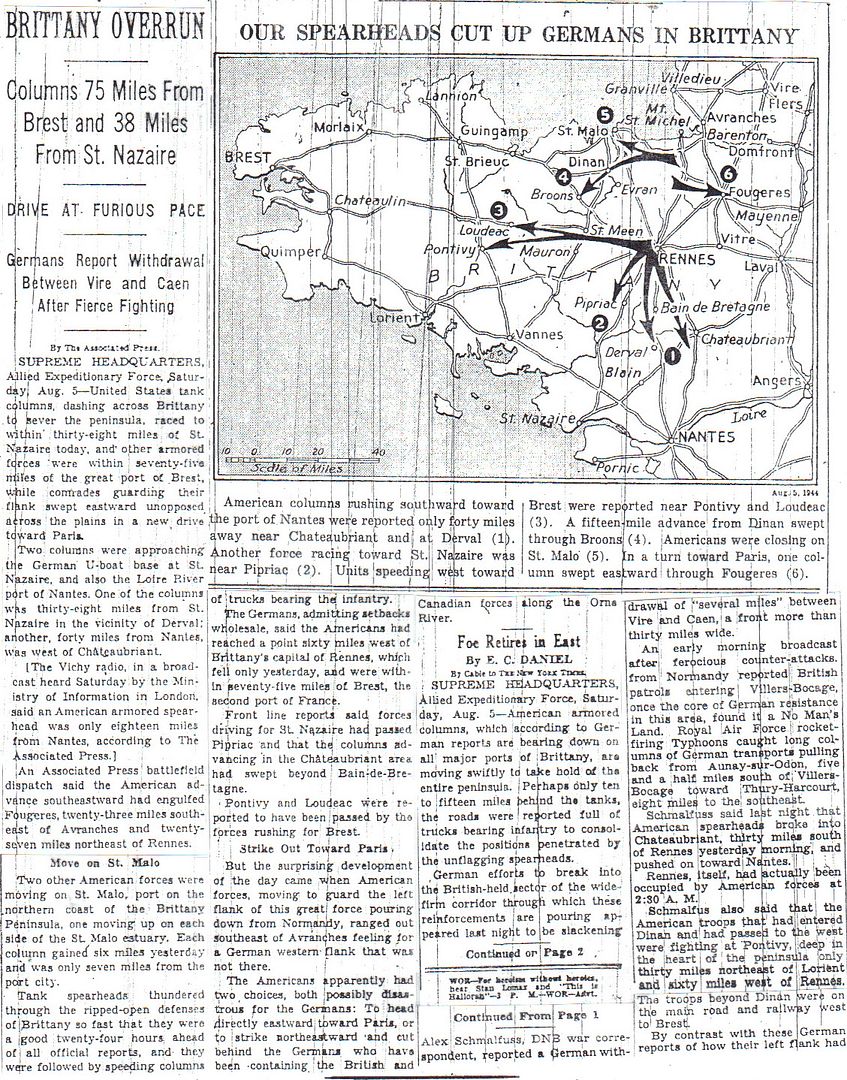
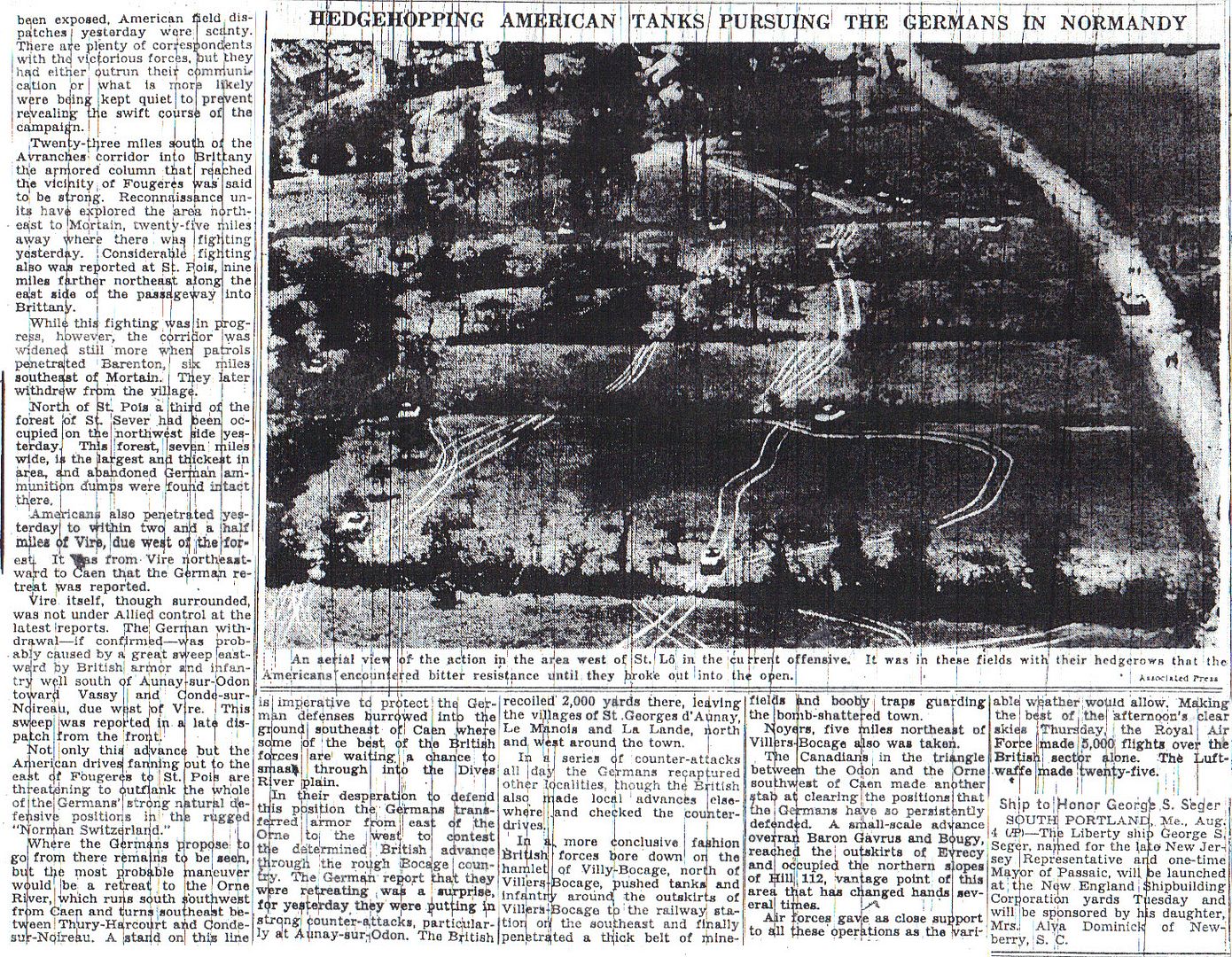
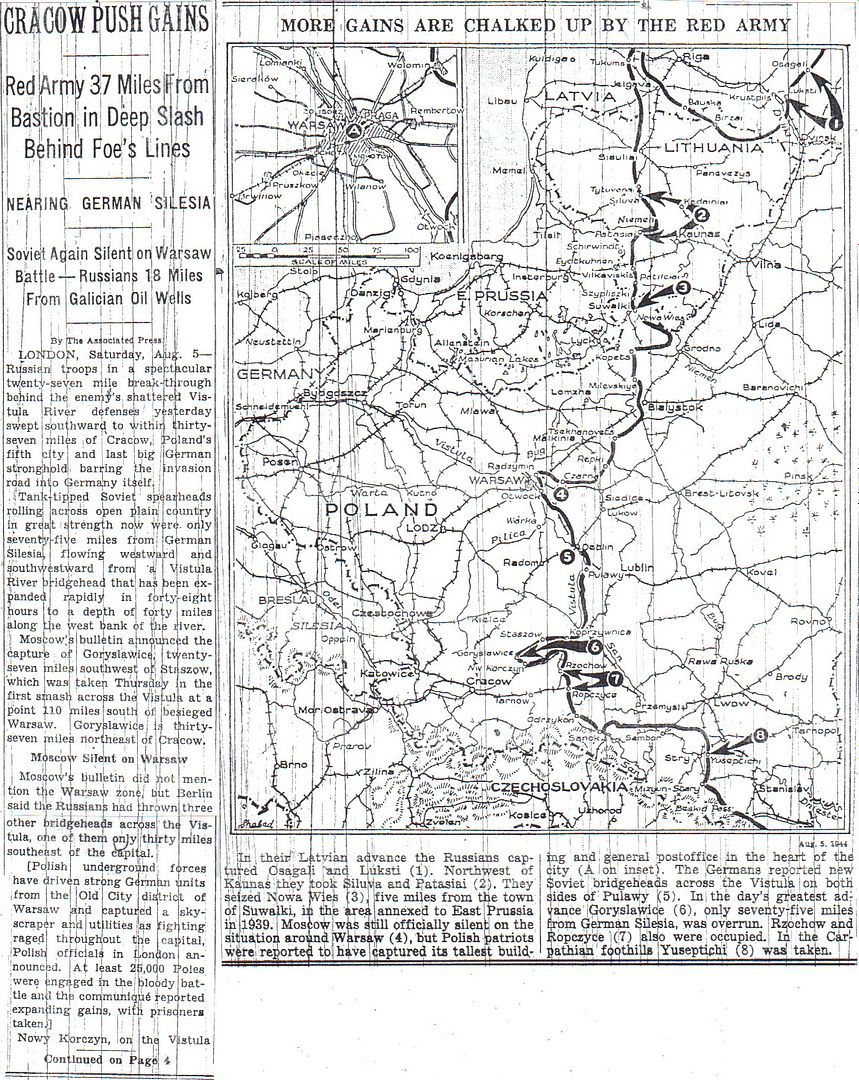

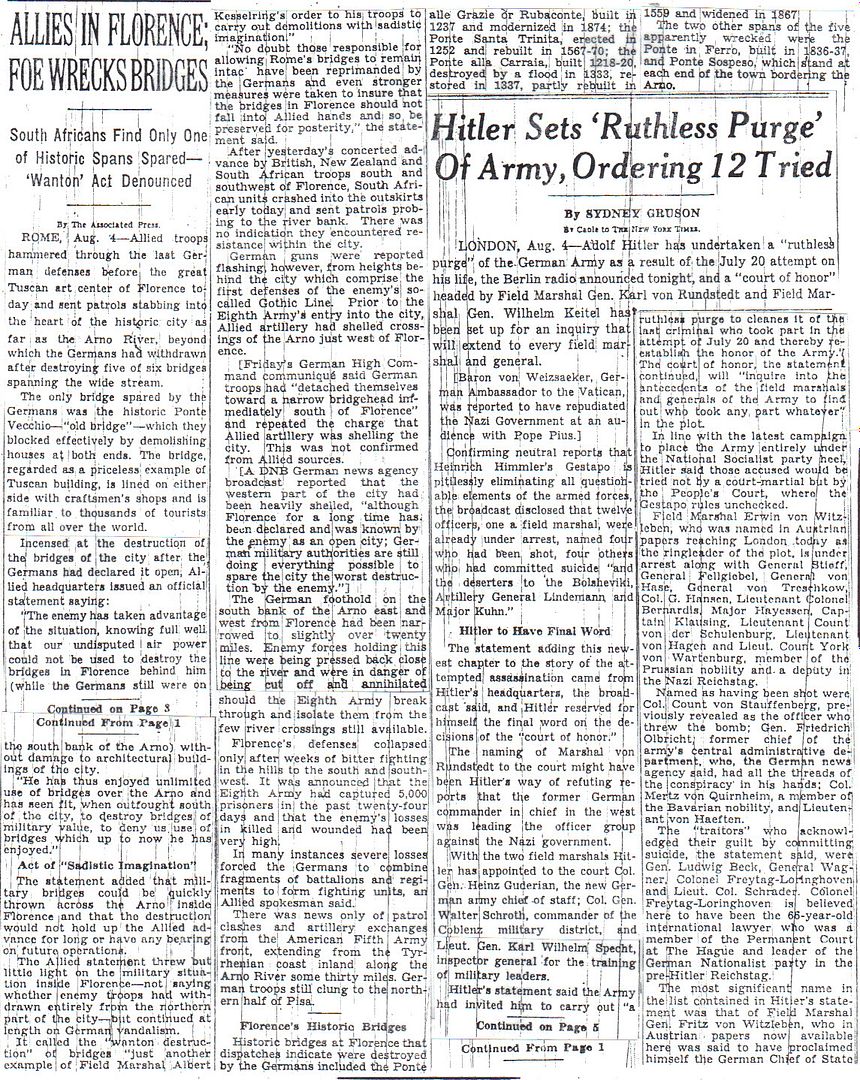
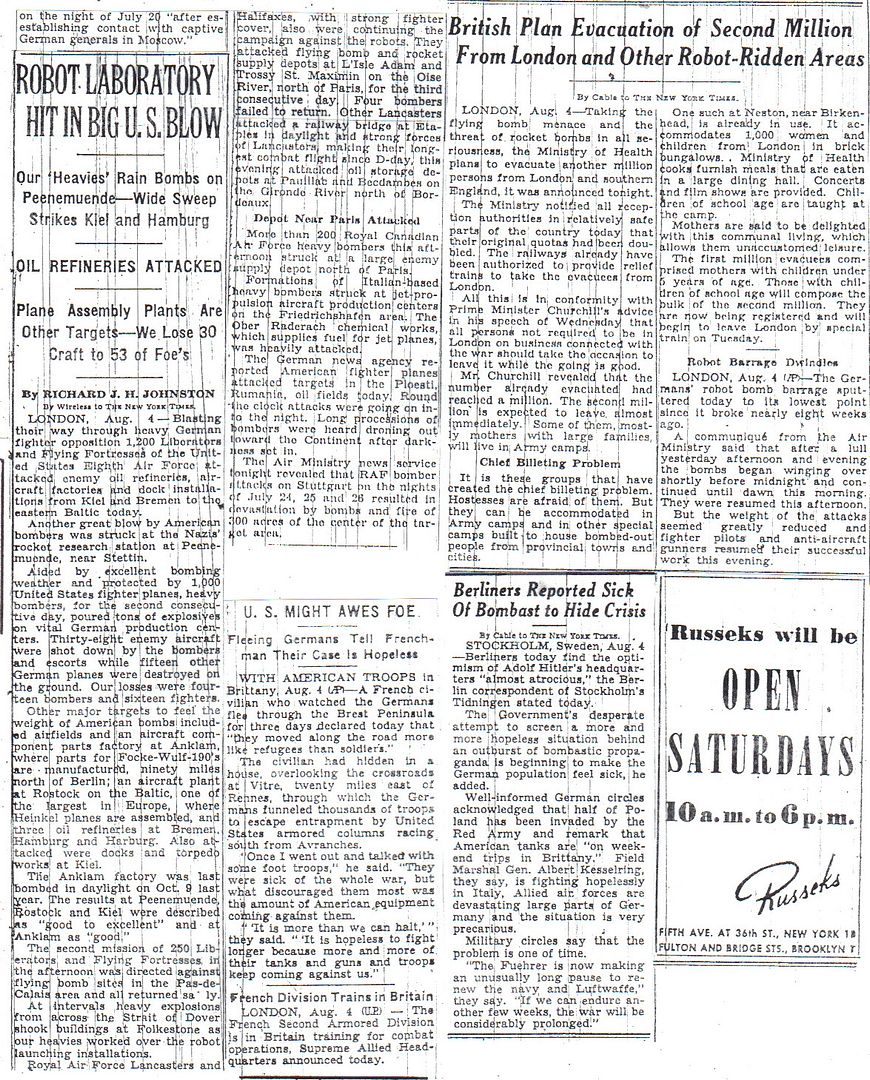
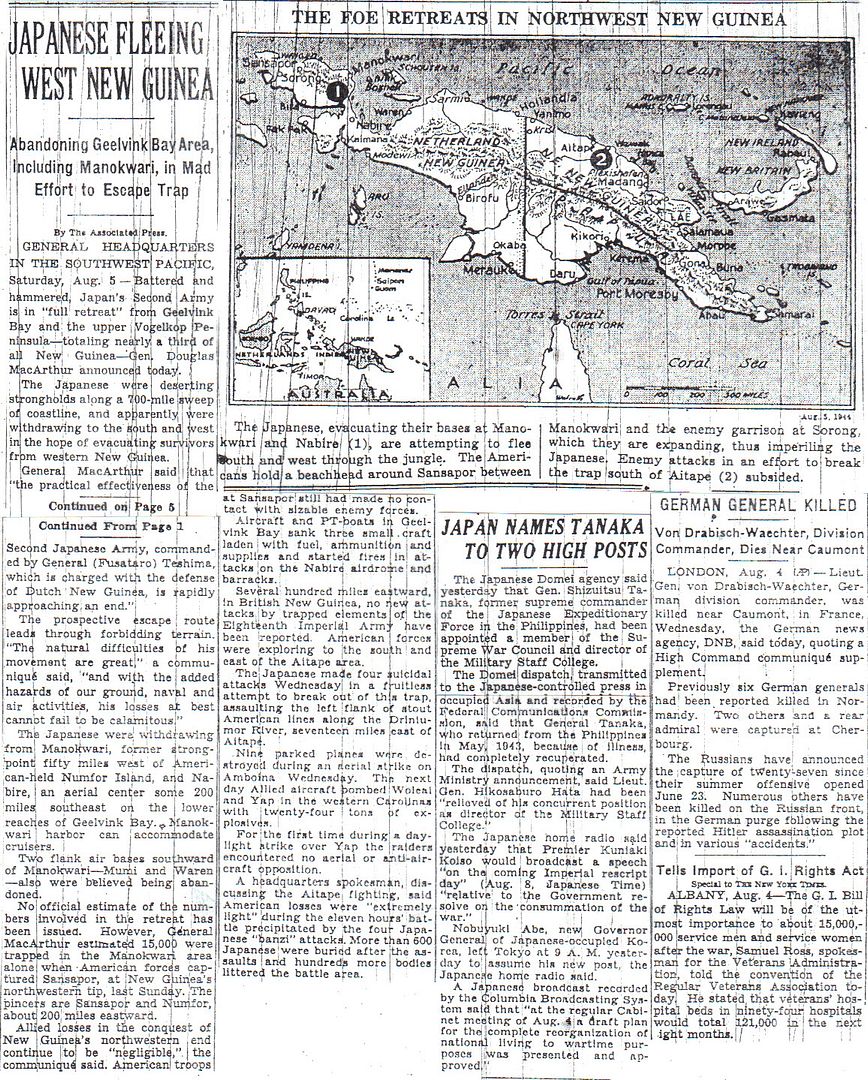
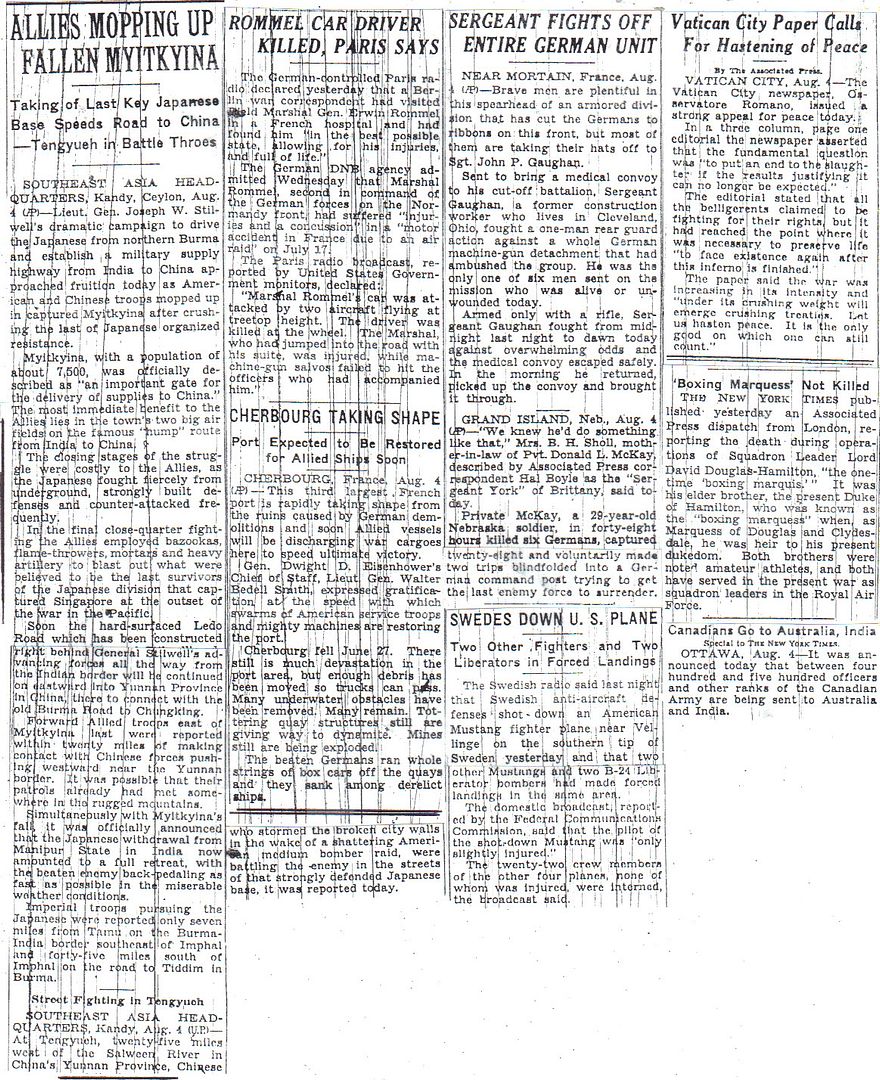
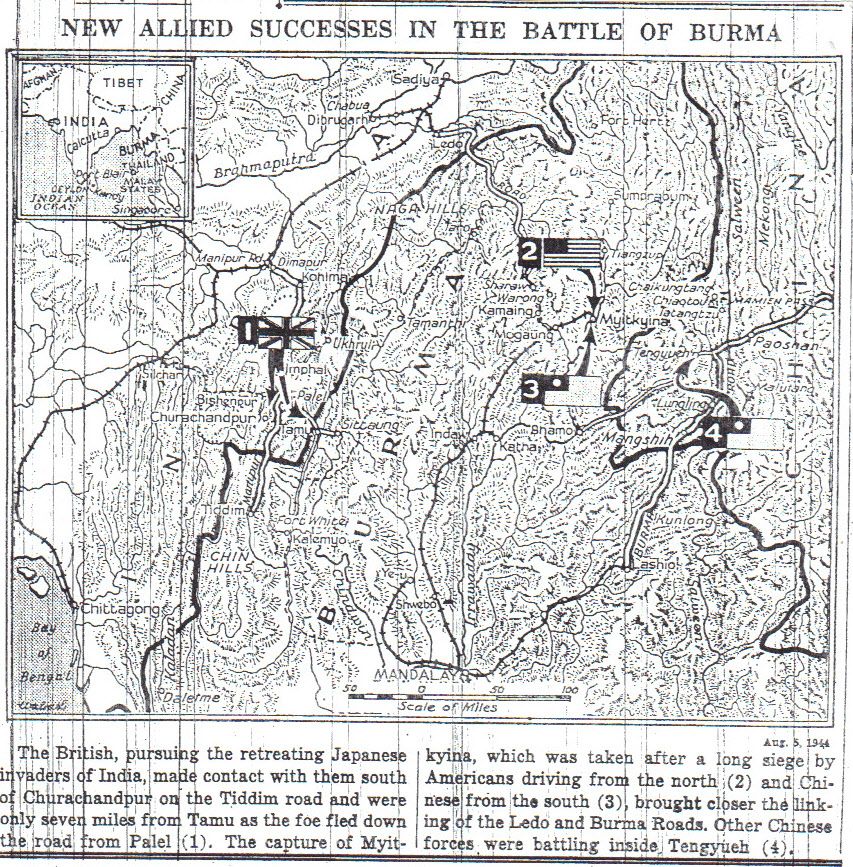
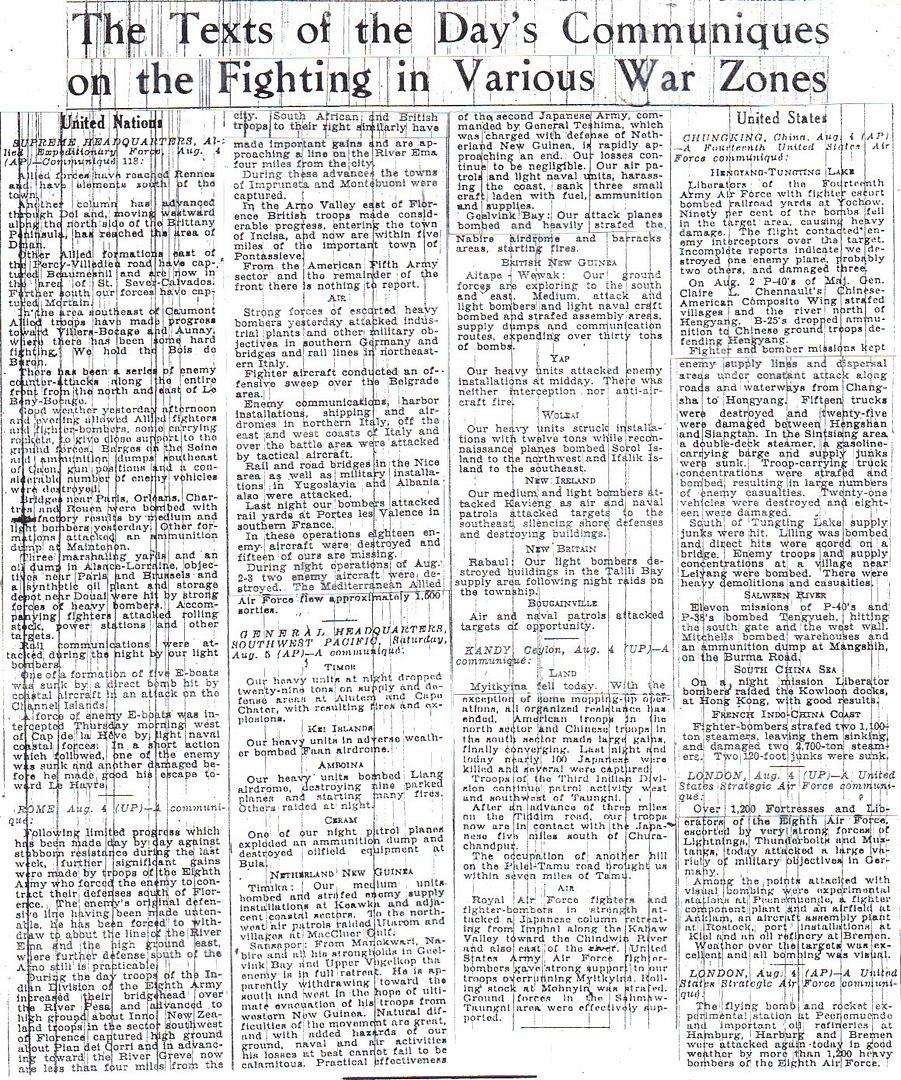
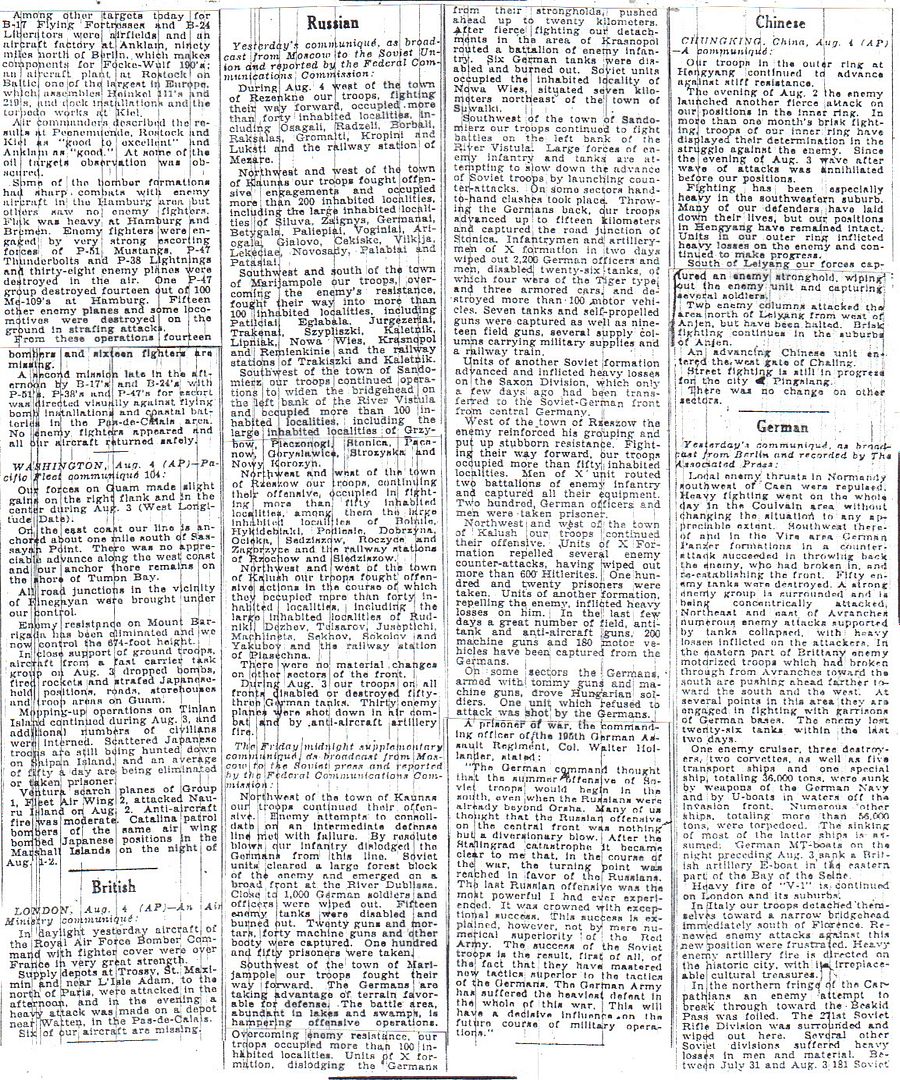
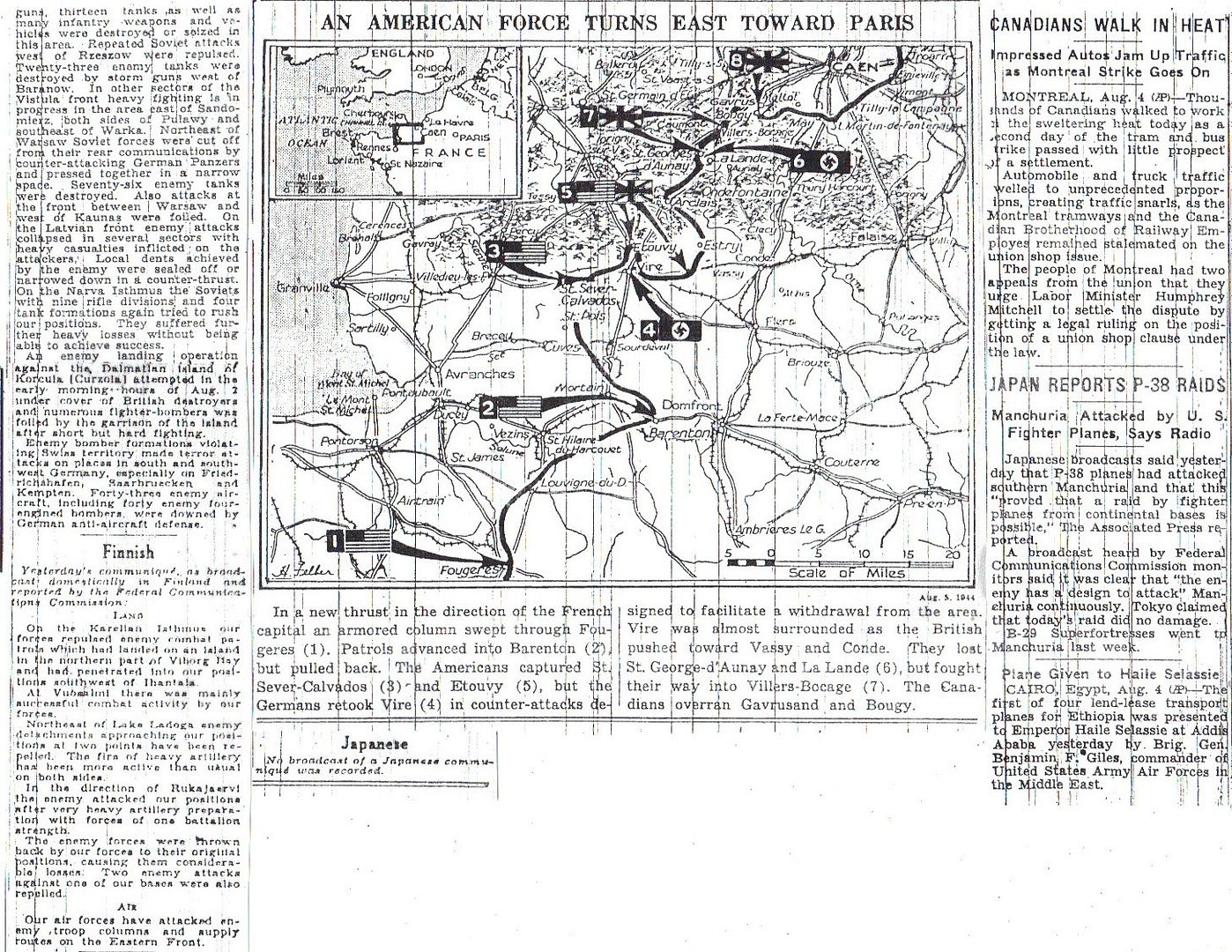
#1 - “Swinging on a Star” – Bing Crosby
#2 - “I’ll Be Seeing You” – Bing Crosby
#3 – “I’ll Get By” - Harry James, with Dick Haymes (reissue of 1941 recording)
#4 – “Amor” - Bing Crosby
#5 - “G.I. Jive” – Louis Jordan
#6 – “I’ll Be Seeing You” – Tommy Dorsey, with Frank Sinatra
#7 - “Time Waits for No One” – Helen Forrest
#8– “Long Ago (and Far Away)” – Bing Crosby
#9 - “I’ll Walk Alone” – Martha Tilton
#10 - “Long Ago (and Far Away)” – Jo Stafford
http://www.onwar.com/chrono/1944/aug44/01aug44.htm#
The Warsaw Uprising
Tuesday, August 1, 1944 www.onwar.com
In Occupied Poland... In Warsaw, the Polish Home Army initiates an uprising against the German occupation. These forces are formally under the direction of the Polish government in exile located in London. The timing of this action is intended to liberate Warsaw, by Polish forces, prior to the arrival of Soviet forces (which is, however, expected to take place shortly).
On the Eastern Front... Soviet troops of 3rd Belorussian Front (Chernyakhovsky) capture Kaunas, capital of Lithuania. Many of the routes leading to East Prussia from the Baltics have been cut, trapping the sizeable German forces of Army Group North. Meanwhile, Red Army forces approach the Vistula River on a broad front.
In Helsinki... President Ryti resigns and Marshal Mannerheim is selected as his replacement.
On the Western Front... The US 3rd Army (General Patton) becomes operational on the right flank and is tasked with clearing Brittany. American forces are now organized under US 12th Army Group (Bradley) and include US 1st Army (Hodges) as well as 3rd Army. The British 21st Army Group (Mongomery) command British 2nd Army (Dempsey) and Canadian 1st Army (Crerar). Field Marshal Montgomery retains overall command of Allied ground forces and General Eisenhower remains Commander in Chief of the Allied Expeditionary Forces.
In the Mariana Islands... Organized Japanese resistance on Tinian comes to an end. Most of the garrison, over 6000, have been killed and 250 have been captured. American forces have suffered 390 killed and 1800 wounded.
http://www.etherit.co.uk/month/thismonth/05.htm
August 5th, 1944(SATURDAY)
UNITED KINGDOM: The German submarine U-671 is sunk at 0200 hours local in the English Channel south of Brighton, England in position 50.23N, 00.06E, by depth charges from the RN frigates HMS Stayner and HMS Wensleydale. 5 of the 52 crewmen survive.
During the day, RAF Bomber Command dispatches aircraft to bomb oil storage and V-1 targets. The targets are (numbers in parenthesis indicate number of aircraft bombing and number lost, e.g., 97-1)
- Oil storage: Blaye (95-0); Bassens at Bordeaux (112-0); Pauillac at Bordeaux (94-1)
- Railroad bridge at Etaples (13-0)
- U-boat pens at Brest (17-0)
- V-1 site at Acquet
- V-1 supply sites: Foret de Nieppe (281-0) and St. Leu D’Esserent (441-1)
During the night of 5/6 August, RAF Bomber Command three RAF Bomber Command aircraft lay mines off Brest while five others drop leaflets.
The USAAF’s Eighth Air Force flies four missions.
The USAAF Eighth Air Force flies Mission 519: 543 B-17 Flying Fortresses and B-24 Liberators bomb numerous targets during the morning. The targets are (numbers in parenthesis indicate number of aircraft bombing and number lost, e.g., 97-1):
- Aircraft assembly plants: Halberstadt (Fw-190, 71-1); Langenhagen at Hannover (Fw-190, 140-0); Neupetritor at Brunswick (components, 33-0); Neustadt at Magdeburg (engines, 92-1); Querum at Brunswick (engines, 95-1); Waggum at Brunswick (Me-110, 68-1); and Wilhelmitor (Me-110, 69-3)
- Airfields: Goslar (7-0); Heligoland (1-0); Helmstedt (15-0); and Nordholz (2-0)
- Industrial areas: Dedelstorf, Helmstedt and Magdeburg (each 1-0),
- Oil refinery: Dollbergen (72-0)
- Oil storage: Nienburg (175-2)
- Targets of opportunity: 13-0)
- Vehicle assembly plant: Krupp at Magdeburg/Buckau (86-2); NAG at Brunswick (43-0); Volkswagen at Fallersleben (85-2)
During the night of 5/6 August, 34 RAF Bomber Command aircraft bomb the Krupp Treibstoff synthetic oil refinery at Wanne-Eikel without loss.
- Mission 520: 34 B-17s hit six V-weapon sites in the Pas de Calais at Flers (14-0); Coubronne, Crepieul and Fleury (each 6-0) and Fressin (2-0). Escort is provided by 10 P-51s. Dick Johnson, who flew one of the six aircraft that bombed Crepieul, reports the following: “The 303d Bomb Group had been flying two missions per day for some time and today each squadron planned to launch ten B-17s each for a total of 40 planes. This was a rush job and Beiser was leading our 427th Squadron and only six of us made formation with their assigned group. A few of the planes were so rushed that they weren’t fully loaded with bombs. We were to bomb six different targets in France in support of the ground troops. We assembled over Harrington Buncher at 3,500 feet (1 067 meters) and since we were late in taking off we took a short cut to Splasher 10 and then directly to Beachy Head at 20,000 feet (6 096 meters). As a result of this short cut three of our planes couldn’t catch up and so they tacked onto another squadron. Our three plane squadron’s target was Crepieul, France where we did a ten minute bomb run. Flak gunners did not fire on us as they did some of the others and as a result none of our planes were damaged. In the “A” Squadron the lead plane received a hit that disabled the manual aileron controls and tumbled the gyros that operated the auto pilot just 45 seconds before bombs away. The bombardier recovered just in time to do a fair job in his bombing attempt. The “D” squadron was 20 minutes late when they had to circle in order to avoid a large formation of British Lancasters in their path. At the target one plane was hit by flak that disabled two engines. That squadron flew a direct route to England after bombs away and the disabled plane landed at Ford, Sussex, England, which is near the White Cliffs of Dover. We saw two Me-163 ‘Komet’ rocket planes but with their five to six minute fuel supply they could not reach our 303rd squadrons. Our P-51s shot down several German fighters that day and I think that this was the intent of the mission: to lure up the German fighters so that our fighters with their superior numbers could eliminate them. This was a “FUBAR” mission from the word go, but it was a milk run for me. and it was Beiser’s last mission. But I had two more to go. I had the same co-pilot as yesterday’s mission but with a mixed crew who were making up missed missions. Why me, Lord? On my penultimate mission on August 7th I would be bombing Paris. Score; Milk runs 14, Others 16.”
- Mission 521: In a Micro H test, two B-17s, escorted by eight P-51 Mustangs, bomb a power plant at Beuvry without loss.
- Mission 522: six B-17s drop leaflets in the Netherlands and France during the night.
- 19 B-24s fly CARPETBAGGER missions during the night.
Corvette HMS Denbigh Castle launched.
FRANCE: US troops capture Namur and Charleroi.
Brittany: Men of Lt-Gen George S Patton’s Third Army, newly arrived in France are racing towards the ports of Brittany after a spectacular breakout from Normandy. Armoured units are moving so rapidly that they are out of radio contact with divisional HQ, and supplies are being delivered on the run since there has been no time to set up bases and dumps. In five days, advance units have reached Lorient after driving past Rennes, and within 24 hours other units will be on the outskirts of Brest. All German forces in Brittany are withdrawing to the ports, which have been heavily fortified, and Hitler has ordered them to be held to the last man. For the first time in the Allied campaign French resistance fighters are operating alongside regular Allied troops. Some 20,000 armed men and women are under the command of a French officer parachuted in from London along with arms and ammunition.
At Pont Mikael in Brittany, the U.S. 15th Tank Battalion was assigned to the 6th Armored Division, having landed at Utah Beach on 18 July. The breakout at Avranches on 30 July and the drive to capture the Brittany Ports saw the 4th and 6th Armored divisions race across the Brittany peninsula, with some elements covering up to 26 miles (42 kilometres) in a day. Having fought their way through Poullaouen, the “point” of the advanced guard, consisting of one platoon of medium tanks from Company B, the 15th and one platoon of infantry from Company B, 9th Armored Infantry Battalion, as CCR (Combat Command Reserve) continued their advance toward Huelgoat, in central Brittany, at 1750 hours with Brest as their ultimate destination. The “point” was ordered to proceed rapidly toward Huelgoat. Lieutenant Schnepp proceeded without mishap until he neared the road junction about three miles east of Huelgoat, known locally as Pont Mikael. Here he found a hasty minefield across the
highway and reported it to the advance guard commander. At this place there was a bank on one side and a stream on the other making it impossible to bypass the mines. Lieutenant Schnepp proceeded through the minefield straddling the mines as he went, closely followed by his other two tanks. All went well until negotiating the second bank of mines, Lieutenant Schnepp’s tank struck a mine blowing off both tracks. At this time the Germans opened up with very heavy small arms fire from all sides. Lieutenant Schnepp and his driver, Private Bennett, were both killed by machine gun fire as they tried to escape from the disabled tank. Lieutenant Colonel Lagrew went forward to investigate the situation and found that there was no room to deploy and attack. He decided to push forward through the minefield. He called for a squad of engineers to clear the mines and ordered the Reconnaissance Platoon to reconnoitre for other mines and for possible routes around them. Then he ordered Lieutenant Bigelow to bring his assault guns forward to support the attack. Lieutenant Durden led the remnants of his Reconnaissance Platoon to Pont Mikael, ascertained the nature, extent and location of the German concentrations and transmitted this information to the Task Force Commander. Lieutenant Durden took the lead in the fighting; walked down the road removing mines and directing drivers of the buttoned up tanks, while constantly under machine gun and rifle fire, and was killed by German machine gun fire. (For his conspicuous gallantry, Lieutenant Durden was posthumously awarded the Distinguished Service Cross). The assault guns were able to get through the first minefield. However, the assault gun ammunition half-track hit a mine and was disabled. Lieutenant Bigelow ordered them to fire into the woods and at likely gun positions. The Battalion Commander and the S-3 (Major White), followed the Assault Gun Platoon on foot to inspect the first minefield and to place the infantry, which was advancing on foot, in position. A burst of machine gun fire wounded Lieutenant Colonel Lagrew, and he was evacuated by the medics. Major White then assumed command of the Battalion and reported the situation to the Reserve Command Commander. He then went forward and made a personal Reconnaissance of the road junction. When Major White reached the Assault Gun Platoon’s position, he found that they had set fire to several ammunition dumps. A supply truck was burning on the left fork of the road and the road to the right was through a defilade and was mined. Considerable small arms fire was still being received from various parts in the woods and. Lieutenant Bigelow’s assault guns were running low on ammunition. Major White reported the above situation to Colonel Hanson (Commander of Reserve Command) who noted the lateness of the hour, and ordered a withdrawal from the defile to the high ground east of Pollaouen. After ordering Company B and the Assault Gun Platoon to withdraw behind a bend in the road, Major White went forward to see what equipment could be salvaged and to see about recovering the bodies of Lieutenant Schnepp and Private Bennett. However, just as they reached the bodies, the Germans opened fire again. Lieutenant Weider (Battalion Liaison Officer), who was accompanying Major White on foot, was mortally wounded. Lieutenant Bigelow then called for a tank from Company B to protect the withdrawal of the troops and equipment, staying with the infantry until everyone was clear and then relieved them at 2245 hours. The command moved into a temporary bivouac just east of Pollaouen and remained there until about 0300. (Chris Warne) [NOTE: This action is in the neighbourhood of Chris’ parents house.]
The USAAF’s Ninth Air Force dispatches 300+ A-20 Havocs and B-26 Marauders to bomb Saint-Malo harbour and Foret de Sille fuel dump during the night of 4/5 August, and during the day, rail bridges at 6 cities in northern and western France, and marshalling yard at Compiegne; fighters furnish cover for ground forces and fly armed reconnaissance over wide areas of northern France.
GERMANY: U-2506 launched.
POLAND: In Warsaw, Polish insurgents loyal to their government-in-exile in London liberate a German forced-labour camp, freeing 348 Jewish prisoners, who join in a general uprising against the German occupiers of the city. By this date, more than 15,000 Poles have been killed in the uprising.
RAF bombers make supply drops to the Warsaw insurgents. (Corinne Mahaffey)
FINLAND: Kenraalimajuri (Major General) Einar Wihma is killed in a Soviet artillery barrage in Ihantala. Wihma, the commander of the 6. Infantry Division, had successfully fought at the battle of Ihantala where a major Soviet offensive was stopped only a month earlier (Wihma earned the 2nd class Mannerheim Cross, the Finnish equivalent of MOH or VC in late 1941 for personal bravery when commanding the 12th Division). Since then the front has grown quiet, but the Russians has constructed a base only 200 meters (c. 220 yards.) away from the Finnish lines, protected by immobilized tanks. The base is such a nuisance that it is decided it has to be destroyed. After aerial and artillery bombardment a special task force attacks under cover of a smoke screen. Nine tanks are destroyed by satchel charges, but Gen. Wihma is killed in a Soviet counter-barrage while observing the operation.
The last word on Gen. Wihma should be left to author and poet Lasse Heikkilä, who fought in the Battle of Tali-Ihantala as a young AT-man.
After the war he began to write a poetic anthology of the men who had fought in Tali-Ihantala, but it was left unfinished when he committed suicide in 1961. The work was published posthumously few years ago.
This is what Heikkilä wrote of Gen. Wihma:
“Mene ja kerro, että meillä jokaisella on nimi,/mene ja kerro, että suomalainen kenraali makaa saman mullan alla kuin sotamiehet,/saman kunnian kantaen kuin sotamiehet.”
Translation:
“Go and tell, that each and every one of us has a name,/go and tell, that a Finnish general lies below the same ground as the privates do,/bearing the same honour as the privates do.”
EASTERN FRONT: The Fourth Ukraine Front, under Petrov, is activated by the Soviets in southern Poland and northern Hungary.
ITALY: Florence: Although Marshal Kesselring solemnly declared this Medici capital an “open city”, South African troops entered it today to find five of Florence’s six bridges destroyed and mediaeval buildings flattened by demolition charges. Only the exquisite Ponte Vecchio with its goldsmiths’ and jewellers’ shops remains standing over the Arno River and, as in many other places, many old houses have been destroyed and the approach roads mined to delay Allied access.
Now depleted by the removal of American and French troops for the planned invasion of southern France, the US Fifth and British Eight Armies have advanced steadily on both sides of the Apennines. The British XIII Corps, augmented by South Africans, Indians and New Zealanders, took the important rail junction of Arezzo on 17 July and pressed on towards Florence despite tough defensive fighting by German paratroopers and Panzergrenadiers. Replacements on the Italian front include 25,000 men of the Brazilian Expeditionary Corps and the US 96th Division, consisting entirely of black troops. Neither unit has battle experience.
AUSTRALIA: Cowra, New South Wales: Japanese prisoners of way wielding improvised weapons broke out of the Cowra prisoner-of-war camp early today. As they rushed the compound wire, Australian Army guards fired a machine-gun at them until the Japanese knifed and clubbed them to death.
Of the 1,104 Japanese prisoners in the camp, 334 managed to get away, and 234 died and 108 were wounded in the attempt. Three of the camp’s army guards were killed and three wounded.
The Japanese had long planned to break out. This incident, the biggest prison escape of the war so far, is the first of its kind to take place in Australia.
Two of the guards, Pte Benjamin Gower Hardy (b.1898) and Pte Ralph Jones (b.1900), Australian Military Forces, were beaten to death at their gun during a mass breakout of Japanese PoWs. By standing their ground, however, they had gained valuable time for their colleagues. (George Crosses)
PACIFIC OCEAN: Carrier-based aircraft from the USN’s Task Group 58.1 (Rear Admiral Joseph J. Clark) and TG 58.3 (Rear Admiral Alfred E. Montgomery) and cruisers and destroyers (Rear Admiral Laurance T. DuBose) repeat strikes on Japanese installations on Chichi Jima and Haha Jima in the Bonin Islands. Aircraft from the aircraft carrier USS Bunker Hill (CV-17) inflict further damage upon fast Japanese transport T.4 and damage T.2 off Chichi Jima.
U.S. submarines sink a Japanese merchant passenger/cargo ship and an oiler.
TERRITORY OF ALASKA: ALEUTIAN ISLANDS: A weather mission is followed by a shipping sweep flown by 2 USAAF Eleventh Air Force B-25 Mitchells which is aborted early due to weather.
CANADA: HMC MTB 486 commissioned.
Tug HMCS Riverton commissioned.
USAAF Far East Air Force B-24s bomb personnel and supply areas on Yap Atoll in the Caroline Islands.
U.S.A.: Minesweeper USS Ransom commissioned.
Destroyer escort USS McGinty launched.
Here is where we see Allied planning and strategy play out. These divisions stayed too long in Calais due to the decoy of Operation Fortitude. They are taking too long to march to the battlefield in Normandy because Allied air forces have destroyed all the bridges over the Seine. Imagine how the Normandy campaign would have gone if the Germans had been able to quickly assemble these forces by mid-June.
Now I know who prepared the maps, and for whom they were prepared. And what is shown and what is not shown is important as it gives me insights into how Jodl tried to package his information for Hitler's eyes.
Weird stuff going on in London ... good thing the U.S. hit that robot factory.
Oh, I misread: it was a Robot Laboratory!
Another glitch. I reposted the August 1 onwar.com entry. I will try again.
http://www.onwar.com/chrono/1944/aug44/05aug44.htm#
Japanese POWs attempt breakout
Saturday, August 5, 1944 www.onwar.com
In Australia... Japanese prisoners of war attempt a mass breakout from a camp in the New South Wales during the night. A total of 231 Japanese and 3 guards are killed.
On the Western Front... Elements of US 8th Corps (part of US 3rd Army) take Vannes. Other elements attack toward St. Malo and Brest. The US 15th Corps (also part of US 3rd Army) is advancing southeast from the Selune River, reaching Mayenne and Laval. To the left, US 7th Corps (part of US 1st Army) is advancing beyond Mortain.
Over Occupied France... RAF bombers destroy the German U-boat pens at Brest with 12,000 pound bombs.
On the Eastern Front... The Soviet 4th Ukrainian Front (Petrov) is activated in the line in southern Poland and northern Hungary.
It looks like you gave us Jodl's approximation of Third Army HQ and his intel on how many divisions are aimed at the remnants of 7th Army. The next map is directly to the south, with the exposed flank of 7th Army to the north. Le Mans lies just to the right of that map and there is virtually nothing between XV Corp and the town.
This is the first I have seen of extensive use of the black color to show intel/approximations. Was that Jodl's way of trying to get Hitler to authorize withdrawal without coming off as defeatist as Rundstedt and Rommel did?
It was a huge blunder to leave so many units at Pas de Calais and as slow as Monty's progress has been our job could have been much more difficult. But Hitler has done so much to assist the Red Army in the East, aren't we entitled to a share of his blunders?
Looking at these maps everyday as I have been cropping and pasting them, it seems like I pick up another little nuance here and there almost every day.
First, these maps were more or less mass-preprinted. I’d like to see the printing press the Germans geared up for that.
Then, at some point the basic information was placed on them, and appears to be also printed. Or the Germans may have made stamps. Some of the unit logos, etc... are too exact and too consistent to have been handwritten. This is particularly the case for the Lage West intelligence situation maps.
The next layer, if you will, which could be part of the above process, is that an officer draws on additional unit information and the front line in blue ink. The Allied attacks are written in red ink. These were definitely done prior to the briefing.
The final layer is handwritten in either blue, green, red or black pencil. The blue is for present German units, green is projected unit locations, red is present American, and for today the black pencil is a new feature.
My guess is that the black pencil marks were personally made by Jodl, either immediately before the briefing, or may have been made during the course of the briefing while in Hitler’s presence. Given that Jodl knew of Hitler’s ADHD in the briefing room, he probably drew this on the map just before the briefing since Hitler wouldn’t let him have more than 30 uninterrupted seconds to make his pitch. The use of black pencil could mean no more than that’s what Jodl happened to have in his pocket at the time. But given that they were done in pencil rather than ink, all pencil marks may well have been made during the actual briefing.
What I see with the black pencil is Jodl doing exactly what you suggest. He wants to convince Hitler to withdraw by showing him the reality of the situation without actually verbally arguing for it and sounding defeatist. He thinks if Hitler just sees the obvious facts, he will reach the obvious conclusion that retreat is absolutely necessary. And that’s why the information in black that we see on the map was deliberately selected. It was an attempt to make an argument without being argumentative.
Well, Alfred, I’ll give you this much credit. It was a nice try. I look at the map and imagine Jodl in the conference room, patiently going through this blow by blow. I can see the pained expression on Jodl’s face as he lays all this out, only to hear Hitler declare that the solution is to attack at Mortain.
I can understand if Jodl was tempted to grab a bottle of schnapps after such a session.
I never went to school in Leavenworth but even I can tell the situation is hopeless in the 7th Army area. Hell is about to fall on its exposed left flank. And the Germans know the Americans are organizing another field army to come right behind Third Army. The only option is to fall back and look for a place to organize another defense line. More German lives and equipment will be lost before the Bavarian Corporal faces that reality, though.
Yes, it is. I hadn't thought of it that way!
Disclaimer: Opinions posted on Free Republic are those of the individual posters and do not necessarily represent the opinion of Free Republic or its management. All materials posted herein are protected by copyright law and the exemption for fair use of copyrighted works.